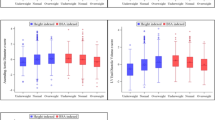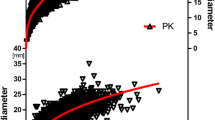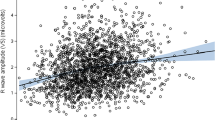Abstract
In pediatric echocardiography, cardiac dimensions are often normalized for weight, height, or body surface area (BSA). The combined influence of height and weight on cardiac size is complex and likely varies with age. We hypothesized that increasing weight for height, as represented by body mass index (BMI) adjusted for age, is poorly accounted for in Z scores normalized for weight, height, or BSA. We aimed to evaluate whether a bias related to BMI was introduced when proximal aorta diameter Z scores are derived from bivariate models (only one normalizing variable), and whether such a bias was reduced when multivariable models are used. We analyzed 1,422 echocardiograms read as normal in children ≤18 years. We computed Z scores of the proximal aorta using allometric, polynomial, and multivariable models with four body size variables. We then assessed the level of residual association of Z scores and BMI adjusted for age and sex. In children ≥6 years, we found a significant residual linear association with BMI-for-age and Z scores for most regression models. Only a multivariable model including weight and height as independent predictors produced a Z score free of linear association with BMI. We concluded that a bias related to BMI was present in Z scores of proximal aorta diameter when normalization was done using bivariate models, regardless of the regression model or the normalizing variable. The use of multivariable models with weight and height as independent predictors should be explored to reduce this potential pitfall when pediatric echocardiography reference values are evaluated.







Similar content being viewed by others
References
Altman DG (1993) Construction of age-related reference centiles using absolute residuals. Stat Med 12(10):917–924
Babu GJ (2011) Resampling methods for model fitting and model selection. J Biopharm Stat 21(6):1177–1186
Bluemke DA, Kronmal RA, Lima JA, Liu K, Olson J, Burke GL, Folsom AR (2008) The relationship of left ventricular mass and geometry to incident cardiovascular events: the MESA (multi-ethnic study of atherosclerosis) study. J Am Coll Cardiol 52(25):2148–2155
Brumback LC, Kronmal R, Heckbert SR, Ni H, Hundley WG, Lima JA, Bluemke DA (2010) Body size adjustments for left ventricular mass by cardiovascular magnetic resonance and their impact on left ventricular hypertrophy classification. Int J Cardiovasc Imaging 26(4):459–468
Cantinotti M, Scalese M, Molinaro S, Murzi B, Passino C (2012) Limitations of current echocardiographic nomograms for left ventricular, valvular and arterial dimensions in children: a critical review. J Am Soc Echocardiogr 25(2):142–152
Colan SD (2013) The why and how of Z scores. J Am Soc Echocardiogr 26(1):38–40
Cole TJ (1990) The LMS method for constructing normalized growth standards. Eur J Clin Nutr 44(1):45–60
Cole TJ, Green PJ (1992) Smoothing reference centile curves: the LMS method and penalized likelihood. Stat Med 11(10):1305–1319
Dallaire F, Dahdah N (2011) New equations and a critical appraisal of coronary artery Z scores in healthy children. J Am Soc Echocardiogr 24(1):60–74
de Onis M, Garza C, Victora CG, Bhan MK, Norum KR (2004) The WHO multicentre growth reference study (MGRS): rationale, planning, and implementation. Food Nutr Bull 25(Suppl. 1):S3–S84
de Onis M, Onyango AW, Borghi E, Siyam A, Nishida C, Siekmann J (2007) Development of a WHO growth reference for school-aged children and adolescents. Bull World Health Organ 85(9):660–667
de Simone G, Daniels SR, Devereux RB, Meyer RA, Roman MJ, de Divitiis O, Alderman MH (1992) Left ventricular mass and body size in normotensive children and adults: assessment of allometric relations and impact of overweight. J Am Coll Cardiol 20(5):1251–1260
de Simone G, Devereux RB, Maggioni AP, Gorini M, de Divitiis O, Verdecchia P (2005) Different normalizations for body size and population attributable risk of left ventricular hypertrophy: the MAVI study. Am J Hypertens 18(10):1288–1293
Du Bois D, Du Bois EF (1916) Clinical Calorimetry: Tenth Paper - A Formula to Estimate the Approximate Surface Area if Height and Weight be Known. Arch Intern Med 17(6–2):863–871
Du Bois D, Du Bois EF (1989) A formula to estimate the approximate surface area if height and weight be known. 1916. Nutrition 5(5): 303–311; discussion 312–303
Foster BJ, Mackie AS, Mitsnefes M, Ali H, Mamber S, Colan SD (2008) A novel method of expressing left ventricular mass relative to body size in children. Circulation 117(21):2769–2775
Foster BJ, Platt RW, Zemel BS (2012) Development and validation of a predictive equation for lean body mass in children and adolescents. Ann Hum Biol 39(3):171–182
Foster BJ, Gao T, Mackie AS, Zemel BS, Ali H, Platt RW, Colan SD (2012) Limitations of expressing left ventricular mass relative to height and to body surface area in children. J Am Soc Echocardiogr 26(4):410–418
Frayn KN, Karpe F, Fielding BA, Macdonald IA, Coppack SW (2003) Integrative physiology of human adipose tissue. Int J Obes Relat Metab Disord 27(8):875–888
Gautier M, Detaint D, Fermanian C, Aegerter P, Delorme G, Arnoult F, Milleron O, Raoux F, Stheneur C, Boileau C, Vahanian A, Jondeau G (2010) Nomograms for aortic root diameters in children using two-dimensional echocardiography. Am J Cardiol 105(6):888–894
Grollman A (1929) Physiologic variations in the cardiac output in man. Am J Physiol 90:210–217
Haycock GB, Schwartz GJ, Wisotsky DH (1978) Geometric method for measuring body surface area: a height-weight formula validated in infants, children, and adults. J Pediatr 93(1):62–66
Lopez L, Colan SD, Frommelt PC, Ensing GJ, Kendall K, Younoszai AK, Lai WW, Geva T (2010) Recommendations for quantification methods during the performance of a pediatric echocardiogram: a report from the Pediatric Measurements Writing Group of the American Society of Echocardiography Pediatric and Congenital Heart Disease Council. J Am Soc Echocardiogr 23(5):465–495 quiz 576-467
Mawad W, Drolet C, Dahdah N, Dallaire F (2013) A review and critique of the statistical methods used to generate reference values in pediatric echocardiography. J Am Soc Echocardiogr 26(1):29–37
Mosteller RD (1987) Simplified calculation of body-surface area. N Engl J Med 317(17):1098
Nevill AM, Bate S, Holder RL (2005) Modeling physiological and anthropometric variables known to vary with body size and other confounding variables. Am J Phys Anthropol Suppl 41:141–153
Overbeek LI, Kapusta L, Peer PG, de Korte CL, Thijssen JM, Daniels O (2006) New reference values for echocardiographic dimensions of healthy Dutch children. Eur J Echocardiogr 7(2):113–121
Pettersen MD, Du W, Skeens ME, Humes RA (2008) Regression equations for calculation of Z scores of cardiac structures in a large cohort of healthy infants, children, and adolescents: an echocardiographic study. J Am Soc Echocardiogr 21(8):922–934
Roman MJ, Devereux RB, Kramer-Fox R, O’Loughlin J (1989) Two-dimensional echocardiographic aortic root dimensions in normal children and adults. Am J Cardiol 64(8):507–512
Sluysmans T, Colan SD (2005) Theoretical and empirical derivation of cardiovascular allometric relationships in children. J Appl Physiol 99(2):445–457
Acknowledgments
FD is a member of the Fonds de Recherche Santé Québec-funded Centre de Recherche du Centre hospitalier universitaire de Sherbrooke (CRCHUS).
Conflict of interest
None.
Author information
Authors and Affiliations
Corresponding author
Electronic supplementary material
Below is the link to the electronic supplementary material.
Rights and permissions
About this article
Cite this article
Dallaire, F., Bigras, JL., Prsa, M. et al. Bias Related to Body Mass Index in Pediatric Echocardiographic Z Scores. Pediatr Cardiol 36, 667–676 (2015). https://doi.org/10.1007/s00246-014-1063-7
Received:
Accepted:
Published:
Issue Date:
DOI: https://doi.org/10.1007/s00246-014-1063-7




